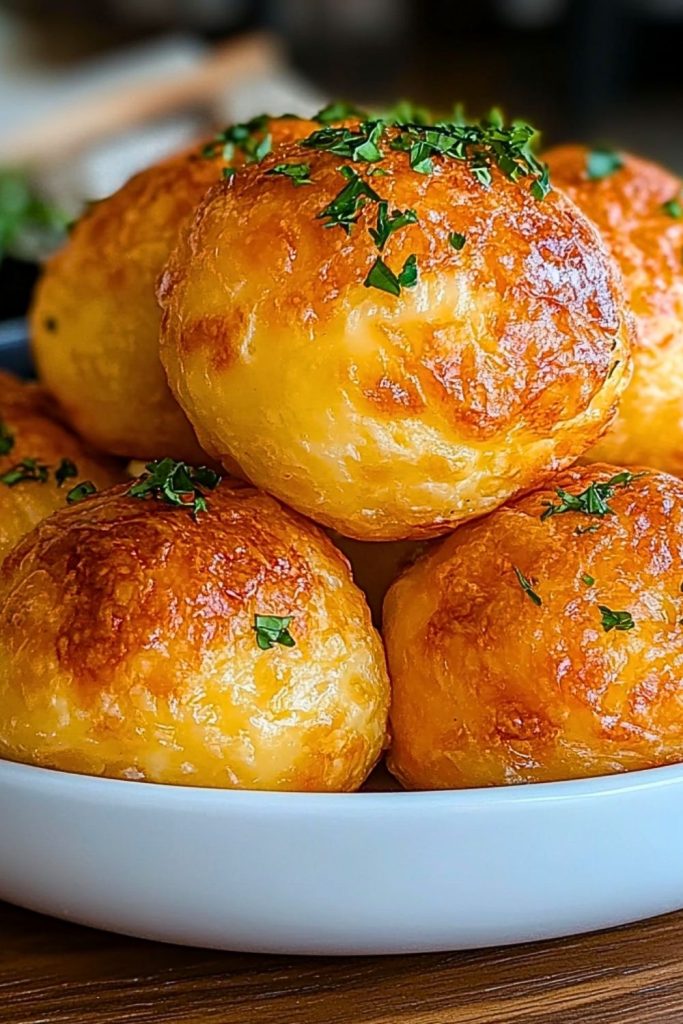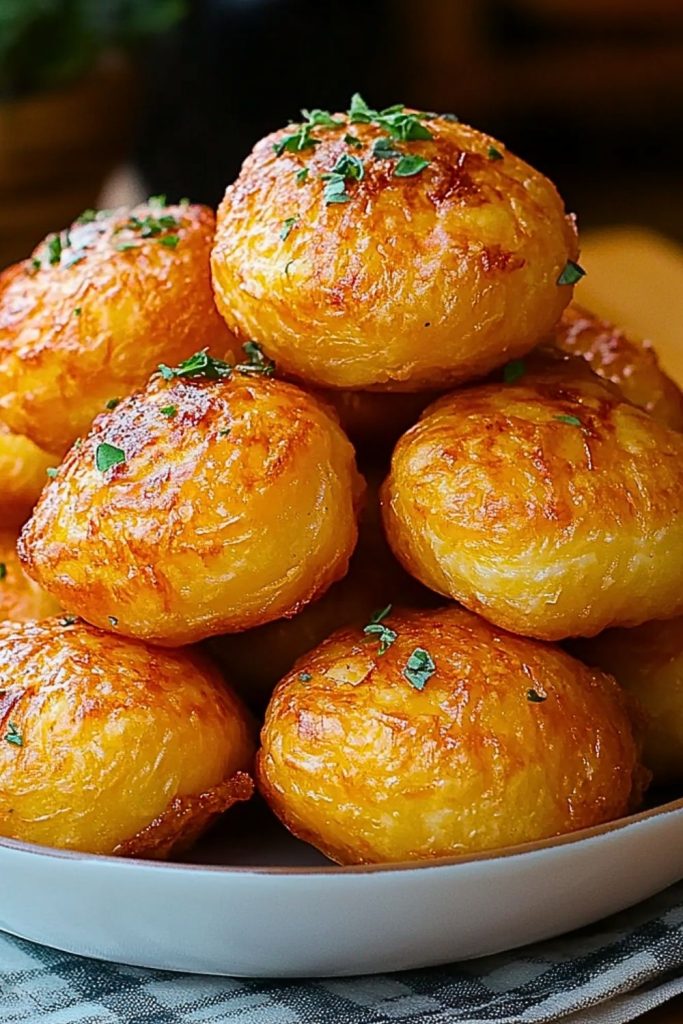Cheese puffs have always had a special place in my heart — golden on the outside, pillowy on the inside, and bursting with rich, melty cheese flavor. I remember the first time I made them at home, and the aroma that filled the kitchen was pure comfort. The crispy shell gives way to a warm, cheesy center that’s impossible to resist. It’s one of those recipes that feels indulgent but is surprisingly simple to pull off.

What I love most about making cheese puffs is how versatile and crowd-pleasing they are. Whether you’re putting together a cozy brunch, looking for a quick snack, or hosting a gathering, these little delights are always a hit. Plus, the texture is perfection — light, airy, and just enough crunch to make each bite satisfying.
Why You’ll Love This Cheese Puffs Recipe
- Incredibly easy to make with just a few pantry staples.
- Crispy outside, fluffy inside, with a satisfying cheese pull.
- Perfect as a party snack, appetizer, or savory breakfast option.
- Great way to use up any leftover cheese in the fridge.
- They freeze beautifully, making them a go-to make-ahead treat.
What Kind of Cheese Should I Use for Cheese Puffs?
The beauty of cheese puffs lies in their adaptability, but choosing the right cheese can elevate them from good to unforgettable. I love using sharp cheddar for that classic tangy flavor and melty texture. It browns beautifully and gives a rich, bold punch that makes the puffs irresistible.
That said, you’re not limited to cheddar. Gruyère is another fantastic choice — nutty and melty, with a slightly more sophisticated taste. Parmesan brings a salty bite and crispiness, especially if sprinkled on top before baking. For a gooier center, you can mix in mozzarella. Combining a few cheeses gives you a more complex flavor and dreamy melt factor.
Options for Substitutions
Whether you’re working around dietary restrictions or just using what’s in the fridge, there are some great swaps you can make:
- Gluten-Free Flour: Substitute all-purpose flour with a gluten-free blend for a celiac-friendly version.
- Milk Alternatives: Use unsweetened almond milk or oat milk in place of dairy milk — just make sure it’s unflavored!
- Butter Alternatives: For a dairy-free puff, opt for plant-based butter that holds up well in baking.
- Cheese Variations: Swap in pepper jack for a little spice, feta for a briny twist, or vegan cheese for a plant-based option.
- Egg-Free: While tricky (since eggs give structure), a mixture of flaxseed meal and water can work in a pinch for a more rustic version.
Ingredients for This Cheese Puffs Recipe
Each ingredient in this recipe plays a key role in creating the perfect texture and flavor. Here’s a breakdown of what you’ll need and why it’s essential:
- All-Purpose Flour
Provides the structure and body of the puffs. It helps trap steam during baking, giving the puffs their signature lift. - Butter
Adds richness and helps create that irresistibly golden, crispy exterior. It also contributes to the dough’s flexibility when mixed with flour and liquid. - Eggs
Crucial for puffiness! Eggs provide moisture, structure, and a touch of richness. They help the dough expand in the oven and set with a soft, custardy interior. - Milk
Adds moisture and enhances the softness of the interior. It also helps bind the ingredients smoothly while giving the puffs a tender crumb. - Cheese (like sharp cheddar)
The star of the show. It melts into the dough and creates pockets of gooey, savory goodness. Sharp varieties give the most flavor, but feel free to blend for complexity. - Salt
Balances the richness of the cheese and butter and elevates all the flavors. Even a small amount makes a big difference. - Optional: Garlic Powder or Paprika
Just a pinch can add an extra layer of flavor, perfect if you’re aiming for a more savory, seasoned twist.

Step 1: Prepare Your Ingredients
Before anything else, pre-measure your ingredients and set them out. Grate your cheese (freshly grated melts better than pre-shredded), and bring the butter, milk, and eggs to room temperature — this helps everything mix together more smoothly.
Step 2: Make the Dough Base
In a medium saucepan, combine the milk, butter, and a pinch of salt. Heat it over medium until the butter is completely melted and the mixture begins to gently simmer.
Remove from heat, and immediately stir in the flour all at once. Stir vigorously with a wooden spoon until the dough pulls away from the sides of the pan and forms a smooth, cohesive ball.
Step 3: Cool Slightly, Then Add Eggs
Let the dough cool for 5 minutes — this prevents the eggs from scrambling when added. Once slightly cooled, add the eggs one at a time, beating well after each addition. The dough will look slippery and separated at first, but keep mixing until it’s thick, glossy, and uniform.
Step 4: Fold in the Cheese
Now the fun part: fold in your grated cheese until evenly distributed throughout the dough. You can taste-test the dough at this point (just a tiny bit!) to see if it needs more salt or a pinch of garlic powder or paprika.
Step 5: Shape and Bake
Preheat your oven to 400°F (200°C). Line a baking sheet with parchment paper. Using a small cookie scoop or a spoon, drop tablespoon-sized portions of dough onto the sheet, spacing them about 1.5 inches apart.
Bake for 20–25 minutes, or until the puffs are golden brown, crisp on the outside, and light in the center.
How Long to Cook the Cheese Puffs
Cheese puffs need just the right amount of time in the oven to get that iconic texture — puffed and golden outside, airy and soft inside. Here’s the sweet spot:
- Bake at 400°F (200°C) for 20 to 25 minutes
You’ll want to keep an eye on them in the final minutes. Look for a deep golden color and a dry, slightly crackled surface. Avoid opening the oven early, or they might collapse before fully setting inside.
If you’re making smaller or larger puffs, adjust the time by a few minutes accordingly. Smaller ones may only need 18 minutes, while oversized puffs could go closer to 28 minutes.
Tips for Perfect Cheese Puffs
- Use freshly grated cheese: Pre-shredded cheese contains anti-caking agents that prevent smooth melting. Grate your own for the best texture.
- Don’t skip cooling the dough before adding eggs: Hot dough can cook the eggs prematurely, ruining the emulsion.
- Beat each egg thoroughly: Make sure each egg is fully absorbed before adding the next for smooth, glossy dough.
- Space them properly: Cheese puffs expand as they bake. Give them room on the sheet so they don’t stick together.
- Bake until deeply golden: Pale puffs may look done but could be doughy inside. Wait until they’ve reached a rich golden brown.
- Serve immediately: These are best enjoyed fresh from the oven when they’re still warm and light.
- Reheat gently: If making ahead, pop them in a hot oven (350°F/175°C) for 5 minutes to crisp them up again.
- Double the batch: You’ll wish you had — they go fast!
Watch Out for These Mistakes While Cooking
Even though cheese puffs are relatively simple to make, a few small missteps can really affect the outcome. Here’s what to avoid:
- Adding eggs to hot dough: This is the most common error. If the dough is too warm, the eggs will scramble. Let it cool for a few minutes first.
- Not stirring vigorously after adding flour: The dough needs to form a smooth ball — under-mixing here will give you uneven texture.
- Overloading with cheese: While tempting, too much cheese can make the puffs greasy and heavy. Stick to the recommended amount for balance.
- Using cold eggs or milk: Room temperature ingredients blend better and help create that smooth, elastic dough.
- Opening the oven too early: This can cause your puffs to deflate before they’ve set. Be patient and peek only near the end.
- Undercooking: Pale tops mean soggy centers. Wait for a rich golden color.
- Crowding the baking sheet: Cheese puffs expand as they cook — give them space to rise and breathe.
- Skipping the parchment paper: It ensures they don’t stick and makes cleanup a breeze.
What to Serve With Cheese Puffs?
Cheese puffs are fantastic on their own, but pairing them with the right sides or dips turns them into a full-blown experience.
1. Creamy Tomato Soup
The ultimate comfort combo — dip a warm cheese puff into tangy tomato soup for a nostalgic bite.
2. Charcuterie Board
Add them to a platter with cured meats, pickles, and olives for a savory balance of textures and flavors.
3. Garlic Herb Butter
Serve with a small dish of whipped herb butter or compound butter for spreading or dipping.
4. Fresh Salad
Pair with a crisp arugula or mixed greens salad with lemon vinaigrette — light and zesty to contrast the richness.
5. Scrambled Eggs or Omelet
Perfect for a brunch spread! Cheese puffs make an excellent bready side to soft eggs.
6. Roasted Vegetables
Earthy and caramelized veggies like Brussels sprouts, carrots, or sweet potatoes go great with cheesy, savory puffs.
7. Spicy Aioli or Sriracha Mayo
For dipping lovers, a spicy, creamy dip adds a fun kick.
8. Chili or Stew
A warm bowl of hearty chili or a rich stew paired with cheese puffs turns it into a cozy dinner idea.
Storage Instructions
Cheese puffs store beautifully, which makes them a dream for prepping ahead or saving leftovers — if you can resist eating them all in one sitting!
- At Room Temperature: Store cooled cheese puffs in an airtight container for up to 2 days. They’ll lose a bit of crispness but are still delicious.
- In the Fridge: For longer storage, place them in an airtight container or zip-top bag and refrigerate for up to 5 days. Reheat in the oven to bring back that crispy texture.
- Freezer-Friendly: Cheese puffs freeze exceptionally well! Once cooled, place them in a single layer on a baking sheet and freeze until solid. Then transfer to a zip-top bag and freeze for up to 2 months. Reheat straight from the freezer at 350°F (175°C) for about 8–10 minutes.
Estimated Nutrition
Here’s an approximate breakdown for one medium cheese puff, though it will vary depending on the cheese and exact size:
- Calories: 80–100
- Fat: 6–7g
- Saturated Fat: 3–4g
- Carbohydrates: 4–6g
- Protein: 3–4g
- Fiber: <1g
- Sugar: <1g
- Sodium: 120–180mg
These are rich little bites, so a few go a long way in satisfying cravings. Perfect for a savory snack or part of a balanced plate.
Frequently Asked Questions
1. Can I make the dough ahead of time?
Yes, you can make the dough a few hours in advance and keep it covered in the fridge. When you’re ready to bake, let it sit at room temperature for 10–15 minutes before scooping and baking.
2. Why did my cheese puffs turn out flat?
Flat puffs are usually a sign that the dough was too runny or the oven temperature wasn’t high enough. Be sure to measure the flour carefully and preheat your oven fully.
3. Can I use a food processor or mixer to make the dough?
You can, but traditional stovetop mixing with a wooden spoon gives better control over the dough texture. If using a stand mixer, mix on low and watch the consistency closely.
4. Do I need to grease the baking sheet?
Parchment paper is the best option — no greasing needed, and it ensures even baking and easy cleanup.
5. Can I add herbs or spices to the dough?
Absolutely! Try adding a teaspoon of dried thyme, rosemary, or a dash of cayenne pepper to customize the flavor.
6. What’s the difference between cheese puffs and gougères?
They’re very similar — gougères are the French version of cheese puffs, typically made with Gruyère and choux pastry. This recipe is a more casual, homey take on the same concept.
7. Can I stuff them with something like cream cheese or ham?
Yes! Add a small cube of ham or cream cheese in the center of the dough ball before baking for a surprise filling.
8. How do I know they’re cooked all the way through?
They should feel firm and hollow when tapped and have a golden crust. If they’re too pale or feel soft and heavy, give them a few more minutes.
Conclusion
Cheese puffs are the kind of snack that makes you feel like a kitchen genius with minimal effort. Crisp, golden, and oozing with cheesy flavor, they’re perfect for any occasion — brunches, parties, or just because you’re craving something warm and homemade. I love how flexible they are, and once you make them once, you’ll be tempted to experiment with all kinds of cheeses, spices, and even fillings.
Whether you’re a baking newbie or a seasoned cook, these cheese puffs are sure to become a go-to favorite. Keep a batch in the freezer, and you’ll always have a delicious, comforting bite ready to pop in the oven.

Cheese Puffs
Description
Golden, crispy, and irresistibly cheesy, these homemade cheese puffs are the ultimate crowd-pleaser. Whether you’re hunting for quick breakfast ideas, an easy dinner side, or a healthy snack alternative that still hits the comfort food mark, these airy bites have you covered. Made with simple ingredients like flour, eggs, butter, and cheese, this easy recipe delivers maximum flavor with minimal fuss. The puffs are baked, not fried, and pair beautifully with soups, salads, or even served solo as an appetizer. If you’re looking for easy food ideas or quick recipes that taste like they took all day, these cheese puffs will not disappoint.
Ingredients
- 1 cup all-purpose flour
- 1/2 cup unsalted butter
- 1 cup whole milk
- 4 large eggs
- 1 1/2 cups grated sharp cheddar cheese (or mix of Gruyère and cheddar)
- 1/2 teaspoon salt
- Optional: 1/2 teaspoon garlic powder or paprika
Instructions
- Preheat your oven to 400°F (200°C). Line a baking sheet with parchment paper.
- In a saucepan, heat milk, butter, and salt over medium heat until it just begins to simmer.
- Remove from heat and stir in the flour all at once. Mix vigorously until the dough forms a ball and pulls away from the sides of the pan.
- Let the dough cool for 5 minutes.
- Add eggs one at a time, beating well after each until the dough is smooth and glossy.
- Fold in the grated cheese and any optional seasonings.
- Drop tablespoon-sized portions of dough onto the prepared baking sheet, spacing them about 1.5 inches apart.
- Bake for 20–25 minutes or until golden brown and puffed.
- Serve warm or cool on a rack for later use.

